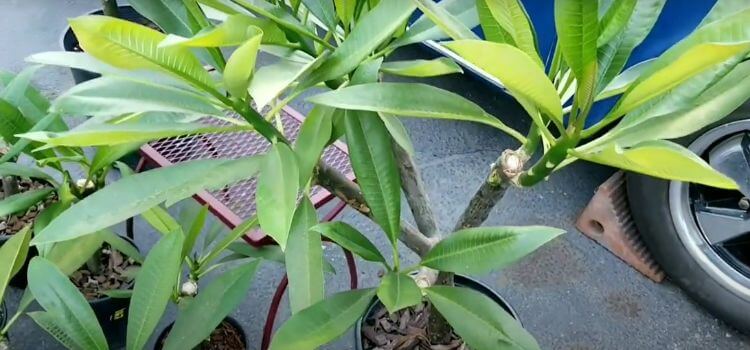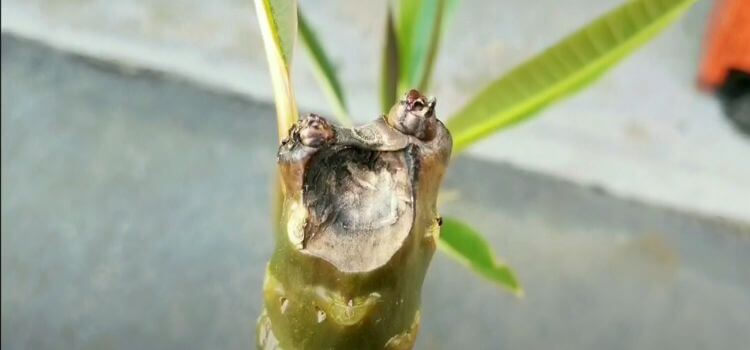As an Amazon Associate, I earn from qualifying purchases.
Plumeria stem rot is a fungal infection causing soft, blackened stems; dehydration leads to wilting and dry stems. Both issues require different care approaches.
Plumeria, known for their fragrant flowers and lush foliage, are susceptible to both stem rot and dehydration, conditions that can severely impact their health. Stem rot, often a result of overwatering or poor drainage, manifests as dark, mushy spots on the stems.
On the other hand, dehydration occurs from inadequate watering or excessive heat, causing the plant to appear limp and its stems brittle. Gardeners must recognize these signs early to save their Plumeria. Proper watering techniques, along with well-draining soil, are crucial in preventing these problems. By ensuring a balance between moisture and drainage, plant enthusiasts can keep their Plumeria thriving and reduce the risk of stem rot and dehydration.
What Is Plumeria Stem Rot
Plumeria, known for its vibrant blooms and lush appearance, can suffer from stem rot, a condition often confused with dehydration due to similar symptoms. Stem rot in plumeria is primarily caused by fungal infections, which can occur when the plant is overwatered or when water is allowed to sit on the leaves or stems for prolonged periods.
The disease manifests as soft, mushy stems, often accompanied by a dark discoloration. Unlike simple dehydration, where the plant’s stems may appear wrinkled or faded due to lack of water, stem rot can cause significant damage to the plant’s vascular system, impeding its ability to transport water and nutrients.
What Is Dehydration
Dehydration in plumerias is a condition characterized by a lack of sufficient water within the plant, leading to drooping leaves, wilting, and a general appearance of dryness. Unlike stem rot, which is a disease caused by fungal or bacterial infections, dehydration results from inadequate watering practices or environmental factors that cause excessive water loss.
Being mindful of your plumeria’s water needs, especially during hot or windy days, is a key responsibility. Ensuring it receives the right amount of water is not just crucial, but also empowers you to maintain its health and resilience against dehydration.
Plumeria Stem Rot vs Dehydration
Causes
Plumeria plants are famous for their vibrant blooms and sweet fragrance. But sometimes, these plants face issues like stem rot and dehydration. Understanding the causes is crucial for healthy plumerias.

Causes Of Plumeria Stem Rot
Stem rot in plumerias often comes from excessive moisture. Here are the leading causes:
- Overwatering: Soil that stays wet can cause roots to rot, spreading to stems.
- Poor Drainage: Waterlogged pots lead to rot. Ensure pots have holes.
- Fungal Infections: Fungi thrive in wet conditions, attacking stems.
- Damage: Broken stems expose the plant to rot-causing pathogens.
Causes Of Dehydration In Plumeria Plants
Dehydration in plumerias can be just as harmful. Here’s what causes it:
- Underwatering: Plumerias need regular watering, especially in the heat.
- High Temperatures: Heat dries out the soil quickly. Plumerias may need more water.
- Low Humidity: Dry air pulls moisture from leaves, causing dehydration.
- Pot Size: Small pots dry out faster. Repot in a larger container if needed.
Symptoms
Identifying the symptoms of illness in your Plumeria is crucial to saving your beloved plant. Plumeria plants, known for their fragrant flowers and lush appearance, can suffer from stem rot and dehydration. Each issue displays distinct symptoms that, if recognized early, can lead to a timely intervention and recovery.
Symptoms Of Plumeria Stem Rot
Stem rot in Plumeria is a severe condition that can quickly jeopardize the health of your plant. Here are signs to look for:
- Soft, mushy stems: The stem feels soft when pressed and may look discoloured.
- Dark, black spots: These can appear on the stem, indicating decay.
- Foul odour: A rotting smell may come from the affected areas.
- Wilting leaves: Even with adequate water, the leaves droop and look unwell.
- Leaf drop: Premature falling of leaves can be a sign of advanced stem rot.
Symptoms Of Dehydration In Plumeria Plants
Dehydration can occur due to lack of water or excessive heat. Watch for these symptoms:
- Curled leaves: They curl inward as they try to conserve moisture.
- Dry, crispy leaves: They feel brittle and may crack when touched.
- Slow growth: The plant’s growth can stall or slow down significantly.
- Wilted appearance: The plant looks droopy and lacks vitality.
- Brown leaf edges: Edges and tips of leaves turn brown and dry.
By looking for these symptoms, you can take swift action to help your Plumeria thrive once again.
Diagnosis
Understanding what ails your plumeria plant is vital to its recovery and lush growth. Diagnosis is the first step in treating plumeria stem rot or dehydration. Recognizing the symptoms early can save your plant. Let’s delve into the specifics of each condition and learn how to identify them correctly.
Diagnosing Plumeria Stem Rot
Plumeria stem rot often stems from fungal infections. It’s crucial to spot the signs before it spreads. Look for:
- Soft, mushy stems that may have a dark or blackened appearance
- Dark spots on the stem, moving upwards from the soil
- Stems that easily break or crumble upon touch
- A foul smell indicating decay within the plant
Immediate action is necessary. Remove the affected parts. Ensure good air circulation and avoid overwatering to prevent recurrence.
Identifying Dehydration In Plumeria Plants
Dehydration in plumerias can be subtle. Be vigilant for:
- Leaves that droop or feel dry to the touch
- Edges or tips of leaves that turn brown or crispy
- Slow growth or reduced flowering
- Stems that appear puckered or wrinkled
Ensure consistent watering. Consider the climate and your soil’s moisture retention. Plumerias need a balance to thrive.
Prevention
Preventing plant ailments and dehydration is critical to maintaining a lush, vibrant garden. Plumeria plants, with their fragrant flowers and glossy leaves, can suffer from stem rot and dehydration, but with the proper knowledge, these issues are avoidable. Discover how to keep your Plumeria in top health through simple preventive measures.
Preventing Plumeria Stem Rot
Stem rot in plumeria plants is a serious condition often caused by fungal infections and poor drainage. Protect your plumerias by following these steps:
- Ensure Good Drainage: Plant plumerias in well-draining soil or pots. Water should never pool around the base.
- Water Properly: Water your plumerias at the base to avoid wetting the leaves and stems, which can lead to fungal growth.
- Clean Pruning Tools: Always use sterilized tools when cutting your plants to prevent the spread of disease.
- Inspect Regularly: Check your plants often for signs of rot, such as blackened stems or a mushy texture.
- Act Quickly: If you spot symptoms, remove the affected parts immediately and adjust your care routine.
Tips To Prevent Dehydration In Plumeria Plants
Dehydration can leave plumerias wilted and weak. Keep your plants hydrated with these tips:
- Morning Watering: Water plumerias in the morning to ensure they have enough moisture throughout the day.
- Check Soil Moisture: Before watering, check if the top inch of soil is dry. If it is, it’s time to water.
- Mulching: Apply a layer of mulch around the base to help retain soil moisture.
- Reduce Sun Stress: In extreme heat, provide some shade to prevent excess water loss from the leaves.
- Monitor Water Needs: Adjust your watering schedule based on the season and weather changes.
Treatment
Treating stem rot and dehydration in Plumeria plants demands specific actions. Each condition requires a targeted approach to ensure your Plumeria thrives. Here are effective treatment strategies:

Treating Plumeria Stem Rot
Identify stem rot early to save your plant. Here’s how to treat it:
- Cut the infected parts with a sterile knife.
- Dispose of rotten segments properly to prevent spread.
- Apply a fungicide on the cut areas to kill the remaining fungus.
- Allow the plant to dry before replanting in fresh, sterile soil.
Regularly check for signs of rot to keep your Plumeria healthy.
Managing Dehydration In Plumeria Plants
Dehydration can severely impact Plumeria. Here are steps to manage it:
| Action | Details |
|---|---|
| Water Deeply | Soak the soil around your Plumeria until it’s moist, not soggy. |
| Increase Frequency | Water more often during hot, dry periods. |
| Mulch | Apply a 2-3 inch layer to retain moisture. |
| Shade | Provide some shade to reduce water loss. |
Consistent care ensures your Plumeria stays hydrated and healthy.
Impact On Plant Health
Plumeria plants, known for their vibrant blooms and lush foliage, face threats from stem rot and dehydration. These conditions profoundly impact their health and vitality. Understanding the signs and effects is crucial for maintaining robust plumerias.
Effects Of Plumeria Stem Rot On Plant Health
Stem rot in plumeria plants is a serious condition caused by fungus or bacteria. It can lead to:
- Wilting leaves: They turn yellow and sag as the disease progresses.
- Blackened stems: Indicative of rot spreading through the plant’s vascular system.
- Soft spots: These are the first signs of rot on the stem, often with a foul odour.
This condition can halt growth and eventually kill the Plumeria if not addressed promptly.
Consequences Of Dehydration On Plumeria Plants
Dehydration in plumerias can lead to a host of issues, such as:
- Curled or droopy leaves: They lose their firmness and hang limply.
- Brown and dry leaf edges: A clear sign of insufficient water intake.
- Stunted growth: With adequate water, plumerias can grow properly.
Regular watering and monitoring soil moisture levels are essential to prevent dehydration.
Frequently Asked Questions
Plumeria stem rot typically appears as soft, mushy, and darkened areas on the stems. These spots may ooze sap and have a foul odour.
Yes, a rotting plumeria can often be saved by cutting away the decayed parts. After removing the affected areas, treat the plant with a fungicide and ensure it has proper drainage. Regularly check for further signs of rot.
To fix frangipani stem rot:
Cut away the rotted parts using a clean, sharp knife until only healthy tissue remains.
Allow the cuts to dry and callous over before replanting in well-draining soil.
Keep the plant dry and avoid water logging to prevent recurrence.
Remove the affected plant parts with sterile tools.
Allow the cuts to air dry, apply fungicide, and repot with fresh soil if necessary.
Ensure proper watering and ventilation to prevent recurrence.
Conclusion
Understanding the differences between plumeria stem rot and dehydration is essential for plant health. Early detection and correct diagnosis can save your plumerias. Ensure they receive proper care and attention. With this knowledge, you can enjoy the vibrant blooms and lush growth of your Plumeria for years to come.

